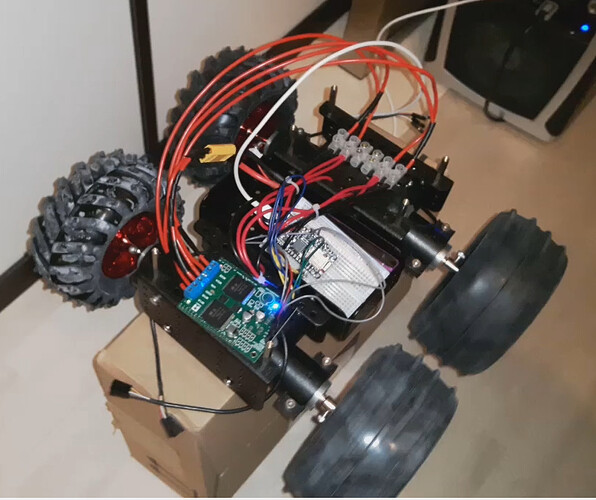Sorry for the late reply,
The modifications are not really note worthy. Basically I changed the PWM Pins in the header file, as they are different on the Feather M0 bord. While doing so I also changed the pin numbers in the cpp file in order to fit them to the Feather.
As for the MxCS Pins, I will give it a try this weekend.
#ifndef DualVNH5019Mod_h
#define DualVNH5019Mod_h
#include <Arduino.h>
class DualVNH5019MotorShield
{
public:
// CONSTRUCTORS
DualVNH5019MotorShield(); // Default pin selection.
DualVNH5019MotorShield(unsigned char INA1, unsigned char INB1, unsigned char EN1DIAG1, unsigned char CS1,
unsigned char INA2, unsigned char INB2, unsigned char EN2DIAG2, unsigned char CS2); // User-defined pin selection.
// PUBLIC METHODS
void init(); // Initialize TIMER 1, set the PWM to 20kHZ.
void setM1Speed(int speed); // Set speed for M1.
void setM2Speed(int speed); // Set speed for M2.
void setSpeeds(int m1Speed, int m2Speed); // Set speed for both M1 and M2.
void setM1Brake(int brake); // Brake M1.
void setM2Brake(int brake); // Brake M2.
void setBrakes(int m1Brake, int m2Brake); // Brake both M1 and M2.
unsigned int getM1CurrentMilliamps(); // Get current reading for M1.
unsigned int getM2CurrentMilliamps(); // Get current reading for M2.
unsigned char getM1Fault(); // Get fault reading from M1.
unsigned char getM2Fault(); // Get fault reading from M2.
private:
unsigned char _INA1;
unsigned char _INB1;
static const unsigned char _PWM1 = 5;
unsigned char _EN1DIAG1;
unsigned char _CS1;
unsigned char _INA2;
unsigned char _INB2;
static const unsigned char _PWM2 = 6;
unsigned char _EN2DIAG2;
unsigned char _CS2;
};
#endif
and for the cpp:
#include "DualVNH5019Mod.h"
// Constructors ////////////////////////////////////////////////////////////////
DualVNH5019MotorShield::DualVNH5019MotorShield()
{
//Pin map
//MODIFIED IN ORDER TO SUIT M0 FEATHER BLE
_INA1 = 12;
_INB1 = 11;
_EN1DIAG1 = 13;
_CS1 = A0;
_INA2 = 0;
_INB2 = 22;
_EN2DIAG2 = 1;
_CS2 = A1;
}
DualVNH5019MotorShield::DualVNH5019MotorShield(unsigned char INA1, unsigned char INB1, unsigned char EN1DIAG1, unsigned char CS1,
unsigned char INA2, unsigned char INB2, unsigned char EN2DIAG2, unsigned char CS2)
{
//Pin map
//PWM1 and PWM2 cannot be remapped because the library assumes PWM is on timer1
_INA1 = INA1;
_INB1 = INB1;
_EN1DIAG1 = EN1DIAG1;
_CS1 = CS1;
_INA2 = INA2;
_INB2 = INB2;
_EN2DIAG2 = EN2DIAG2;
_CS2 = CS2;
}
// Public Methods //////////////////////////////////////////////////////////////
void DualVNH5019MotorShield::init()
{
// Define pinMode for the pins and set the frequency for timer1.
pinMode(_INA1,OUTPUT);
pinMode(_INB1,OUTPUT);
pinMode(_PWM1,OUTPUT);
pinMode(_EN1DIAG1,INPUT);
pinMode(_CS1,INPUT);
pinMode(_INA2,OUTPUT);
pinMode(_INB2,OUTPUT);
pinMode(_PWM2,OUTPUT);
pinMode(_EN2DIAG2,INPUT);
pinMode(_CS2,INPUT);
#if defined(__AVR_ATmega168__)|| defined(__AVR_ATmega328P__) || defined(__AVR_ATmega32U4__)
// Timer 1 configuration
// prescaler: clockI/O / 1
// outputs enabled
// phase-correct PWM
// top of 400
//
// PWM frequency calculation
// 16MHz / 1 (prescaler) / 2 (phase-correct) / 400 (top) = 20kHz
TCCR1A = 0b10100000;
TCCR1B = 0b00010001;
ICR1 = 400;
#endif
}
// Set speed for motor 1, speed is a number betwenn -400 and 400
void DualVNH5019MotorShield::setM1Speed(int speed)
{
unsigned char reverse = 0;
if (speed < 0)
{
speed = -speed; // Make speed a positive quantity
reverse = 1; // Preserve the direction
}
if (speed > 400) // Max PWM dutycycle
speed = 400;
#if defined(__AVR_ATmega168__)|| defined(__AVR_ATmega328P__) || defined(__AVR_ATmega32U4__)
OCR1A = speed;
#else
analogWrite(_PWM1,speed * 51 / 80); // default to using analogWrite, mapping 400 to 255
#endif
if (speed == 0)
{
digitalWrite(_INA1,LOW); // Make the motor coast no
digitalWrite(_INB1,LOW); // matter which direction it is spinning.
}
else if (reverse)
{
digitalWrite(_INA1,LOW);
digitalWrite(_INB1,HIGH);
}
else
{
digitalWrite(_INA1,HIGH);
digitalWrite(_INB1,LOW);
}
}
// Set speed for motor 2, speed is a number betwenn -400 and 400
void DualVNH5019MotorShield::setM2Speed(int speed)
{
unsigned char reverse = 0;
if (speed < 0)
{
speed = -speed; // make speed a positive quantity
reverse = 1; // preserve the direction
}
if (speed > 400) // Max
speed = 400;
#if defined(__AVR_ATmega168__)|| defined(__AVR_ATmega328P__) || defined(__AVR_ATmega32U4__)
OCR1B = speed;
#else
analogWrite(_PWM2,speed * 51 / 80); // default to using analogWrite, mapping 400 to 255
#endif
if (speed == 0)
{
digitalWrite(_INA2,LOW); // Make the motor coast no
digitalWrite(_INB2,LOW); // matter which direction it is spinning.
}
else if (reverse)
{
digitalWrite(_INA2,LOW);
digitalWrite(_INB2,HIGH);
}
else
{
digitalWrite(_INA2,HIGH);
digitalWrite(_INB2,LOW);
}
}
// Set speed for motor 1 and 2
void DualVNH5019MotorShield::setSpeeds(int m1Speed, int m2Speed)
{
setM1Speed(m1Speed);
setM2Speed(m2Speed);
}
// Brake motor 1, brake is a number between 0 and 400
void DualVNH5019MotorShield::setM1Brake(int brake)
{
// normalize brake
if (brake < 0)
{
brake = -brake;
}
if (brake > 400) // Max brake
brake = 400;
digitalWrite(_INA1, LOW);
digitalWrite(_INB1, LOW);
#if defined(__AVR_ATmega168__)|| defined(__AVR_ATmega328P__) || defined(__AVR_ATmega32U4__)
OCR1A = brake;
#else
analogWrite(_PWM1,brake * 51 / 80); // default to using analogWrite, mapping 400 to 255
#endif
}
// Brake motor 2, brake is a number between 0 and 400
void DualVNH5019MotorShield::setM2Brake(int brake)
{
// normalize brake
if (brake < 0)
{
brake = -brake;
}
if (brake > 400) // Max brake
brake = 400;
digitalWrite(_INA2, LOW);
digitalWrite(_INB2, LOW);
#if defined(__AVR_ATmega168__)|| defined(__AVR_ATmega328P__) || defined(__AVR_ATmega32U4__)
OCR1B = brake;
#else
analogWrite(_PWM2,brake * 51 / 80); // default to using analogWrite, mapping 400 to 255
#endif
}
// Brake motor 1 and 2, brake is a number between 0 and 400
void DualVNH5019MotorShield::setBrakes(int m1Brake, int m2Brake)
{
setM1Brake(m1Brake);
setM2Brake(m2Brake);
}
// Return motor 1 current value in milliamps.
unsigned int DualVNH5019MotorShield::getM1CurrentMilliamps()
{
// 5V / 1024 ADC counts / 144 mV per A = 34 mA per count
return analogRead(_CS1) * 34;
}
// Return motor 2 current value in milliamps.
unsigned int DualVNH5019MotorShield::getM2CurrentMilliamps()
{
// 5V / 1024 ADC counts / 144 mV per A = 34 mA per count
return analogRead(_CS2) * 34;
}
// Return error status for motor 1
unsigned char DualVNH5019MotorShield::getM1Fault()
{
return !digitalRead(_EN1DIAG1);
}
// Return error status for motor 2
unsigned char DualVNH5019MotorShield::getM2Fault()
{
return !digitalRead(_EN2DIAG2);
}

